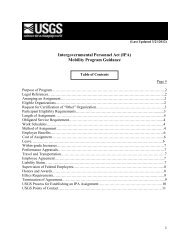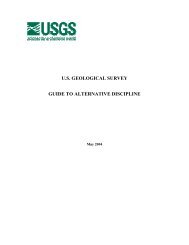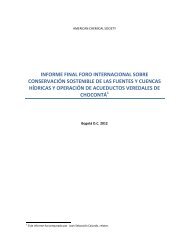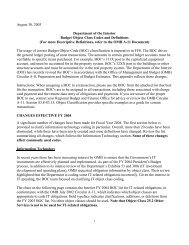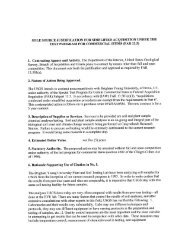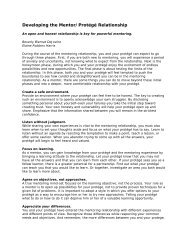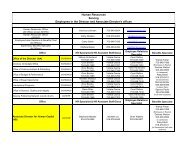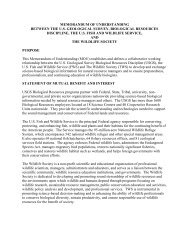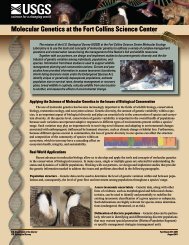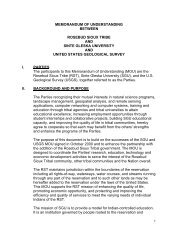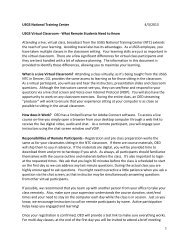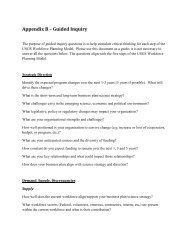Template for Preparing Summary of Peer Reviewer ... - USGS
Template for Preparing Summary of Peer Reviewer ... - USGS
Template for Preparing Summary of Peer Reviewer ... - USGS
You also want an ePaper? Increase the reach of your titles
YUMPU automatically turns print PDFs into web optimized ePapers that Google loves.
that an estimate <strong>of</strong> inhalation be included, as these two factors could increase the risk<br />
substantially. The reviewer also suggested that the manuscript discuss data on<br />
bioavailability <strong>of</strong> PAH and “weathering” over time, and the possible effect on risk. As a final<br />
comment, the reviewer recommended that the amount <strong>of</strong> risk incurred in childhood be<br />
noted in the concluding remarks <strong>of</strong> the Abstract, and also be considered <strong>for</strong> inclusion in the<br />
title, as the amount <strong>of</strong> risk in the early years <strong>of</strong> life is a major finding.<br />
<strong>Peer</strong> <strong>Reviewer</strong> #2: Found this to be a well-written, fairly straight<strong>for</strong>ward, and unique<br />
analysis that is worthy <strong>of</strong> publication. The reviewer noted that the section on uncertainty<br />
was comprehensive and responsible. The reviewer suggested that, given the clarity <strong>of</strong> the<br />
deterministic analysis and the many scenarios modeled, the probabilistic analysis be moved<br />
into the Supplemental In<strong>for</strong>mation, but left it as a judgment call to the authors. The<br />
reviewer also suggested that analyses <strong>of</strong> inhalation and dermal exposure pathways be<br />
included.<br />
<strong>Peer</strong> <strong>Reviewer</strong> #3: Stated that the risk assessment work is a nice addition and a logical<br />
extension <strong>of</strong> the authors’ previous work, and that the manuscript is clearly written and well<br />
organized. The reviewer found the study to be very thorough with ample references and<br />
justification given <strong>for</strong> all <strong>of</strong> the values selected <strong>for</strong> inclusion in the risk assessment. The<br />
reviewer noted that the comprehensive discussion <strong>of</strong> sources <strong>of</strong> uncertainty lent further<br />
confidence to the outcome <strong>of</strong> the analyses. The reviewer also made suggestions <strong>for</strong> minor<br />
editorial revisions.<br />
<strong>Peer</strong> <strong>Reviewer</strong> #4: Considered the paper to be well-written and scientifically sound, and that<br />
it makes a convincing case elevated exposure to PAH associated with proximity to coal-tarsealed<br />
pavement is associated with a significant increase in excess lifetime cancer risk. The<br />
reviewer had no suggestions <strong>for</strong> revision.<br />
<strong>Peer</strong> <strong>Reviewer</strong> #5: Commented that this paper represents the next step in the research on<br />
coal-tar-sealed pavement. The reviewer felt that the use <strong>of</strong> non-parametric statistics would<br />
be more appropriate <strong>for</strong> the data used, and also made suggestions <strong>for</strong> minor editorial<br />
revisions.<br />
<strong>Summary</strong> <strong>of</strong> <strong>USGS</strong> Response to <strong>Peer</strong> <strong>Reviewer</strong> Comments<br />
Almost all editorial revisions suggested by the reviewers were incorporated into the<br />
manuscript, which strengthened the overall clarity. In response to <strong>Reviewer</strong> #1’s request<br />
<strong>for</strong> a hypothetical scenario <strong>for</strong> ingestion <strong>of</strong> pavement dust, the authors generated a scenario<br />
<strong>for</strong> ingestion <strong>of</strong> 4 to 8 mg <strong>of</strong> pavement dust <strong>for</strong> children 0 to 6 years <strong>of</strong> age and<br />
incorporated it into the text. In response to <strong>Reviewer</strong> #1’s comments regarding<br />
bioavailability, the authors chose the default <strong>of</strong> 100% as no site-specific data are available,<br />
but further discussion <strong>of</strong> this issue has been added to the section on uncertainty. In<br />
response to <strong>Reviewer</strong> #1’s comment regarding highlighting the importance <strong>of</strong> childhood<br />
exposure, the authors have added a sentence to this effect to the final part <strong>of</strong> the Abstract.<br />
In response to <strong>Reviewer</strong> #2’s comment regarding relegation <strong>of</strong> the probabilistic analysis to<br />
the Supplementary In<strong>for</strong>mation, the authors felt that because these types <strong>of</strong> calculations<br />
have become standard practice, the probabilistic analysis should be retained in the body <strong>of</strong><br />
the text. In response to <strong>Reviewer</strong> #1 and 2’s suggestion <strong>for</strong> analysis <strong>of</strong> additional exposure<br />
pathways (non-dietary ingestion <strong>of</strong> pavement dust, inhalation, and dermal exposure), the<br />
authors responded that these additional analyses were outside the scope <strong>of</strong> this assessment<br />
<strong>for</strong> a variety <strong>of</strong> reasons (e.g., a lack <strong>of</strong> published ingestion rates <strong>for</strong> pavement dust), but<br />
that these are avenues <strong>of</strong> current research. In response to <strong>Reviewer</strong> #5’s comment<br />
regarding a preference <strong>for</strong> non-parametric statistics, the authors used the non-parametric



